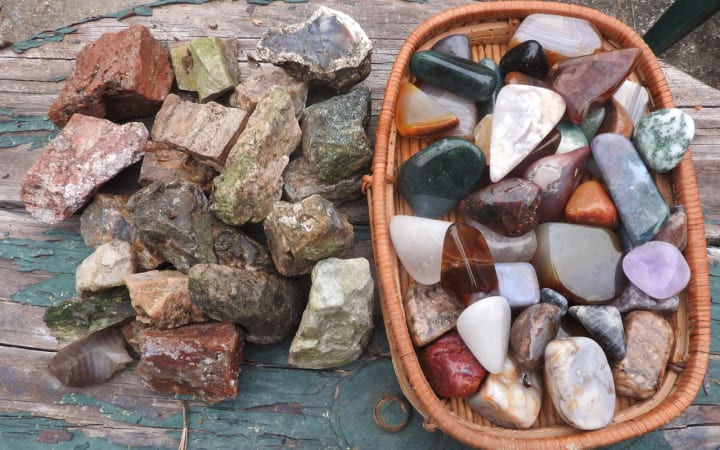The Mindful Meditation of Shaping and Polishing Stone
Time is an illusion when I focus on my craft

“A gemstone carving is time preserved: many efforts requiring time leave no evidence.” --Ed and Leola Wertz's Handbook of Gemstone Carving (1968)
I have never been a person to sit peacefully in the lotus position, candles flickering, incense wafting. My meditative practice is of a more active kind.
Active and yet unhurried. I must be in motion, but I must also exercise patience. My craft asks me to take months-- often years-- to create a finished project.
I am a stone cutter.
Standing at the wet wheel, wearing ear protection, wearing eye protection, wearing old baggy clothes I don't mind getting soaked through, I am in perfect isolation from the concerns of the world. All my focus is on the place where I touch my stone to spinning waterwheel to grind away its imperfections.
Not every imperfection, no. Of course not. You can grind away a whole stone trying to make it too perfect.
Perfection is not-- never can be-- the goal of this art.
Instead, I begin by grinding away saw marks. Then I grind away rough edges. Then I begin to make decisions on the fly.
Can I smooth away this dull sand-colored place to get down to brighter color? Can I shape this lumpy rock into a silky egg? How much must I grind away before this agate turns translucent?

Letting go of over-control of the process
Unlike most hobby stone workers, I started as a cabochon cutter rather than a rock tumbler. Cabochons are jewelry-sized polished stones with flat bottoms and polished display tops. Turquoise, for instance, is often cut into cabochons.
In the beginning, having fixated on their use in pendants, I tried to cut each stone to a certain predetermined shape-- sometimes round but often a 30x40-millimeter oval. I had a lot of vintage brass findings that size, you see.
Soon, I realized such too-precise shapes are done faster and arguably better on commercial equipment. They're cut that way so they snap quickly into too-precise, cookie-cutter commercial jewelry findings.
That won't do. No, it won't do at all. It doesn't satisfy the soul. Often, it doesn't even satisfy the eye.
How is my 30-millimeter tiger eye round any different from a thousand other 30-millimeter tiger eye rounds? If perfect means being the copy of everybody else's perfect stone, why bother?
And so I surrendered control. Instead of aiming for precise ovals and rounds, I discovered beauty in the quick shaping of free forms-- especially rough triangles or teardrops. My focus shifted to the natural pattern and color of the stone, not the Procrustean urge to fit the stone willy-nilly into some pre-existing shape.
No more wrestling match to force a stone into a standard shape cooked up long ago by a commercial seller of cheap findings. No more wrestling match at all.
I was no longer fighting a stone. I was becoming one with the stone. Together, we were making subtle changes and discovering hidden beauties.
Oh, don't get me wrong. I still get soaked to the skin at the waterwheel. But I hardly notice. The time flies, until-- suddenly, laughing-- I realize I must look like a drowned cat.
"Look what I found," I'll say. "Look what's inside of this one."
I've found my bliss.

In the beginning
Of course, the stone-cutting process begins long before I ever touch a wheel. Before I cut a stone, I must choose a stone.
Many people order pre-forms or stone flats from commercial sources. Others are old-school rockhounds who collect stones in the wild.
Some years ago, I made a decision not to collect any more from our weary and over-mined Earth. Instead, I prefer to swap with other hobbyists for material collected long ago. You see, rockhounding was an extremely popular mid-century hobby, especially in the western United States. Since rock doesn't rot, almost all that uncut old material is still floating around waiting to be rediscovered in legacy collections or even uninspiring five-gallon buckets pushed to the back of sheds, barns, and garages.
There's a social element to that kind of rock hunting. Often, instead of somebody buying and somebody selling, we arrange for a swap. One person has more of this. I have more of that. Why not trade? No money changes hands, only stories.

The polishing process
Within a few months of entering the hobby, I bought a rock tumbler. And, not long after that, I developed a personal, if somewhat quirky, system for cutting and polishing my stones.
I do the rough grinding and shaping on the cabbing wheel. I get a general idea of what the shape will be but I don't try to dictate the shape. Instead, when I think it's close enough to turn into something interesting, I drop it into the rotary tumbler. The sanding process takes weeks-- sometimes months. The polishing process usually takes another ten days after that.
Some people prefer to use a vibratory tumbler. It's faster. It's also noisier. I can use the noise as an excuse, but the true reason I prefer a rotary is the slow, patient grind.
I did use a vibratory tumbler at one point in the past, and I didn't like the results nearly as much. For whatever reason, my vibe had a genius for putting a nice slick polish on a dented-looking stone. Other hobbyists often report the same experience.
Well, I'm not in any great tearing hurry. And so I went back to the cabbing wheel, the rotary tumbler, and the practice of patience. It can take months to get a perfect slick polish, but I get it on smooth stones instead of dented ones.

Final steps, final thoughts
In the fullness of time, I collect a lot of finished stones. It sneaks up on me sometimes. One day, I look around and realize I have enough flat-bottom stones to start a new mosaic to display my little treasures.
You can see the kind of easy, casual work I do in the various photographs. I like to make small mosaic objects like boxes, bowls, frames, and tabletops. Once in a blue moon, I'll make a birdbath.
You can use the same glues and grouts you use to do any pique assiette (broken plate) mosaic. Some people put together pictures, while I prefer abstract designs that allow the viewer to focus on the variety and color of the stone. Either way, it takes time to gather enough pieces of the right shape and color for a finished project.
No hurry. Stone is patient and peaceful. It has waited in the earth for millions of years for us to catch up to the hidden beauty within.
“Time preserved,” carvers Ed and Leola Wertz said. I like that.
Although I'm not sure if we actually preserve time-- or if, while working in stone, we step away from normal ideas of time altogether.

If you enjoyed this story, I'd be thrilled if you tapped that <3 button and/or left a tip.
About the Creator
Amethyst Qu
Seeker, traveler, birder, crystal collector, photographer. I sometimes visit the mysterious side of life. Author of "The Moldavite Message" and "Crystal Magick, Meditation, and Manifestation."
https://linktr.ee/amethystqu






Comments
There are no comments for this story
Be the first to respond and start the conversation.